The Samsung 950 Pro PCIe SSD Review (256GB and 512GB)
by Billy Tallis on October 22, 2015 10:55 AM ESTSequential Write Performance
The sequential write test isn't limited to a small span of the disk, as that usually doesn't make a difference for this performance metric. As always, our averages are of the lower queue depths, but scaling to higher queue depths is also investigated. Bulk file copies and recording uncompressed video are the kind of uses that depend on sequential write performance.
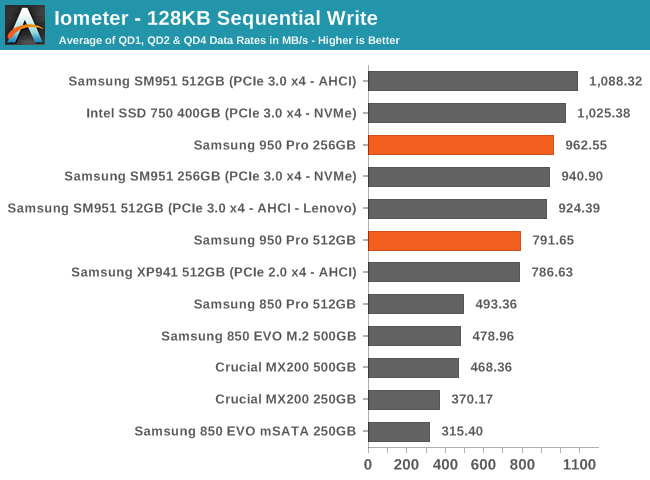
Even at low queue depths, most SSDs can spread a sequential write workload across multiple channels to achieve very high throughput. All of the PCIe drives perform well above the SATA limit but nowhere near the capacity of the PCIe links. The 512GB 950 Pro seems to again be encountering thermal throttling, and more severely than the SM951s we tested.
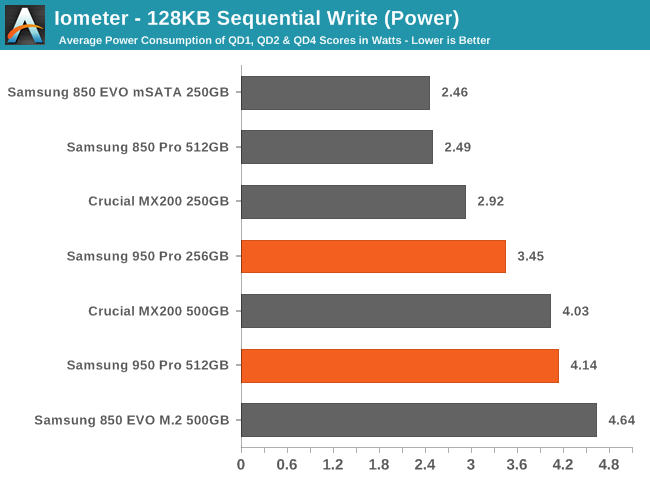
The average power consumption for writes is still on the high side by SATA standards, but is quite reasonable in light of the performance achieved.
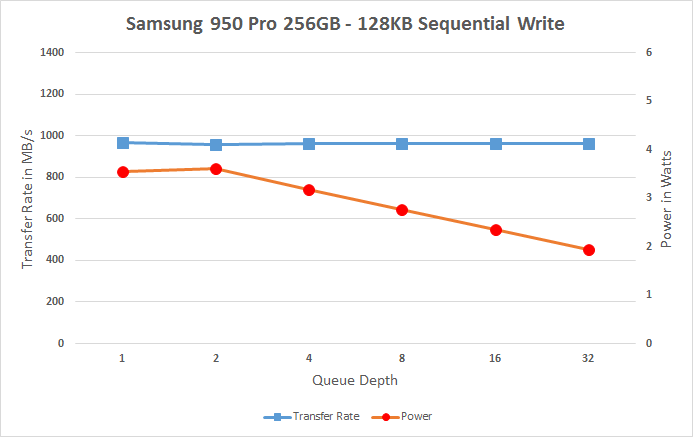 |
|||||||||
Performance across the sequential write test is mostly constant, but power isn't. The declines in power consumption in spite of increased queue depth are again most likely an artifact of whatever background processing is going on in the drive. On SATA drives, it's usually obvious from looking at the power meter when a drive has completed background processing and is truly idle and ready to run the next test, but with the lack of working power management for PCIe drives on our testbed I'm not so sure here. Overall it's probably a good sign that the drives were able to maintain high performance in spite of whatever else was going on, but given more cooling the 512GB can probably do much better.
Sequential Read Performance
Just like the random read test, sequential reads are tested across the span of a full drive and a representative sample of queue depths. Most operations involving large files (typically images and videos) fall under this test's purveiw, but streaming or playing even the highest resolution videos won't be a challenge for any of these drives. Copying files to another SSD or loading a new level in a video game would be more likely to show noticeable difference from better performance here.
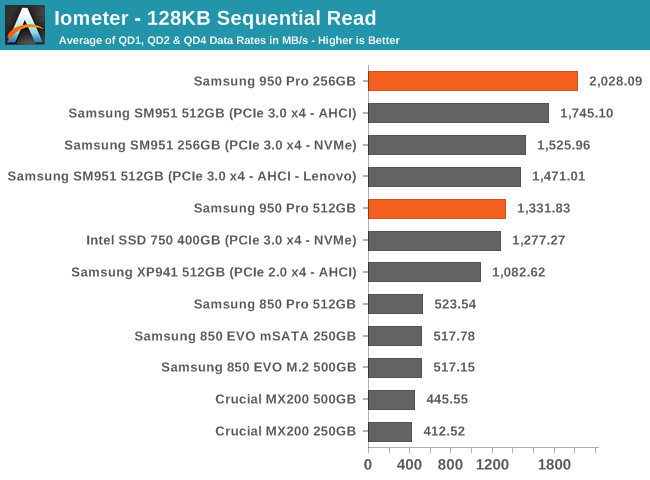
The sequential read performance is probably the best showcase of what the PCIe 3.0 x4 interface can do. The 256GB 950 Pro attains over half of the link speed, but the 512GB is again bogged down by something—relatively speaking, since it's still more than twice the speed of SATA and faster than even the Intel SSD 750. It's possible that the 950 Pro isn't faithfully implementing the secure form of the NVMe format command and some lingering fragmentation is preventing the 512GB drive from performing as specified. Read operations require less power to be supplied to the flash chip than for writes, but if the thermal throttling is all in the controller it could be showing up here as well.
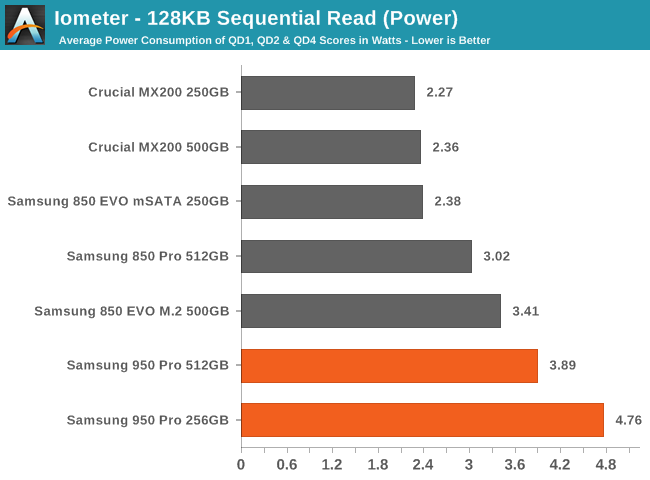
Relative to each other, the 950 Pro's power consumption is in line with the performance they're demonstrating, and proportionally much better than the SATA drives.
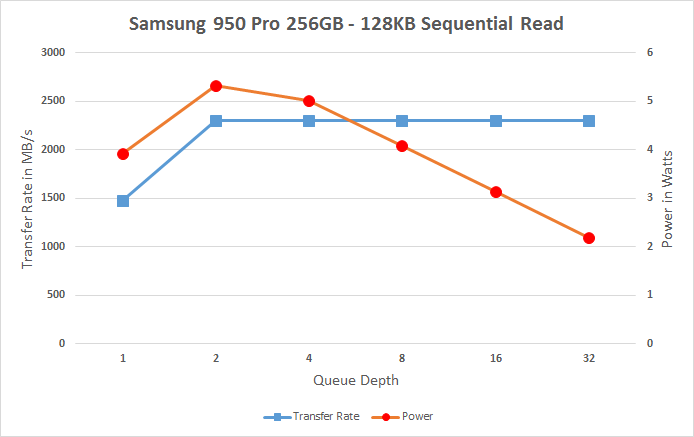 |
|||||||||
At queue depth 1, both of the 950 drives are performing similarly. When moving to higher queue depths the 256GB immediately hits 104% of its rated speed, but the 512GB doesn't improve any. (It's worth noting the differing scale for Transfer Rate in the graphs above.) The puzzling decline in power consumption at higher queue depths shows up again on the 256GB and definitely warrants deeper investigation.










142 Comments
View All Comments
Billy Tallis - Thursday, October 22, 2015 - link
If I'd had more time, I probably would have done more informal testing on some older machines. I can at least assure you that the drive doesn't seem to have any trouble in a PCIe 2.0 x2 M.2 slot on my personal Haswell machine. Next time I'm poking around in my Lynnfield server I'll be checking how the pcie drives work, especially power management. But I probably won't do a full suite of performance tests, just enough to get a rough idea for how fast drives perform on a slower link. And I really don't have a clue when I'll get around to this, because I've still got quite the backlog of drives to review.hansmuff - Thursday, October 22, 2015 - link
Understandable, thanks for the PCIe 2.0 update.The_Assimilator - Thursday, October 22, 2015 - link
Thermal throttling is disappointing but shows that M.2, like SATA Express, is DOA. PCIe drives with heatsinks, or preferably U.2, is the future - hopefully with the Z200 series chipsets, manufacturers will ditch SATAe in favour of U.2 and we can finally get a worthy successor to SATA3.MrSpadge - Thursday, October 22, 2015 - link
DOA it certainly is not. You're free to attach a tiny RAM heatsink on the drive and be fine. Or simply forget about throtteling in real world usage (unless you use it in a server).Redstorm - Thursday, October 22, 2015 - link
Under a normal client workload you don't get anywhere near triggering the thermal protection so adding heat sinks is not required. Agree SATA Express was still born. M.2 is far from it, if you look at any new release ultrabook you will find a M.2 SSD under the lid.The_Assimilator - Friday, October 23, 2015 - link
M.2 is a great solution for replacing 2.5" SSDs in space-limited applications like ultrabooks, but for *absolute maximum performance without thermal throttling*, 2.5" U.2 drives a la Intel's 750 are still the way to go.zodiacfml - Sunday, October 25, 2015 - link
It depends on the designer on how much throttling they would allow or not. U.2 allows more freedom though but I reckon would be much more expensive and less dense in the future.user_5447 - Thursday, October 22, 2015 - link
Why everyone keep saying that BIOS/UEFI must support NVMe to boot into OS?You can install GRUB bootloader on cheap small USB flash drive and use it to boot from NVMe drives on any system, since GRUB itself supports NVMe for few years now.
And yes, GRUB supports booting into Windows 8.1 / 10.
bji - Thursday, October 22, 2015 - link
They say it because it's true. Nobody wants to have to manage a USB drive just for booting their system. You can also install a floppy drive and boot from that, would you recommend that also? How about keeping a separate computer up constantly to support PXE booting from the network? Would you recommend that level of headache to someone who just wants to boot their frickin computer?bji - Thursday, October 22, 2015 - link
By the way, of all of the things I have to deal with when installing/upgrading Linux systems, grub is the most painful and problematic, by MANY orders of magnitude. I would *NEVER* recommend that a non-technical user have anything to do with grub, especially not for something as silly as booting a PC into Windows off of an NVMe drive.